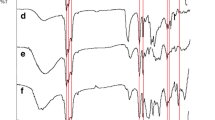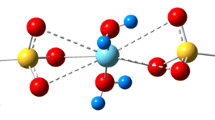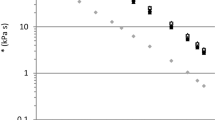Abstract
The thermal and kinetic studies of epoxidized natural rubber (ENR) and its polymer electrolytes, LiX/ENR PEs, (where X = ClO −4 , CF3SO −3 , COOCF −3 , I−, and BF −4 ) were carried out using thermogravimetric analysis at different heating rates. The thermal behaviors for LiX/ENR PEs are closely related to the morphology and interactions between the LiX and ENR chains. The LiCF3SO3, LiCOOCF3, and LiI form pseudo-crosslinking within the ENR; their thermal behavior resembled purified ENR. The LiClO4 tends to form aggregates within the ENR. This phenomenon has promoted a much earlier decomposition of epoxide in the ENR. The occurrence of ring-opening and complexation or cross-linking reactions in and between the ENR chains in the LiBF4/ENR has produced a thermally stable macrostructure. The activation energy for the thermal degradation (E d) of purified ENR was 239.8 and 239.9 kJ mol−1 using Kissinger and FWO methods, respectively. According to the Coats–Redfern method, the degradation mechanism of purified ENR follows the F1 type model, while the Criado method revealed that the degradation starts with F1 followed by D3 type models. The E d for LiX/ENR (X = COOCF −3 , CF3SO −3 , I−, and BF −4 ) PE’s obtained via the Kissinger method are 258.5, 257.0, 251.0, and 198.9 kJ mol−1, respectively, and the corresponding E d values obtained by FWO are 236.0, 223.6, 349.7, and 206.6 kJ mol−1, respectively. The degradation of ENR in these PEs followed the D3 type model. However, for LiClO4/ENR, the presence of two distinct degradations of ENR gave two E d values. These are 174.5 and 234.7 kJ mol−1 using Kissinger and 117.8 and 293.6 kJ mol−1 using FWO method. The degradation mechanism of ENR in the LiClO4/ENR PE was similar to purified ENR that is F1 followed by D3 type models.









Similar content being viewed by others
References
Baker CSL. Modified natural rubber. In: Bhowmick AK, Stephens HL, editors. Handbook of elastomers. 2nd ed. New York: Markel Dekker; 2001.
Gray FM. Solid polymer electrolytes: fundamentals and technological applications. New York: VCH Publishers; 1991.
Idris R, Glasse MD, Latham RJ, Linford RG, Schlindwein WS. Polymer electrolytes based on modified natural rubber for use in rechargeable lithium batteries. J Power Sources. 2001;94:206.
Mohamed SN, Johari NA, Ali AMM, Harun MK, Yahya MZA. Electrochemical studies on epoxidized natural rubber-based gel polymer electrolytes for lithium–air cells. J Power Sources. 2008;183:351.
Glasse MD, Idris R, Latham RJ, Linford RG, Schlindwein WS. Polymer electrolytes based on modified natural rubber. Solid State Ion. 2002;147:289.
Aziz M, Latif F, Chew CL, Katun N. The impedance spectroscopy studies of PVC/ENR-50/LiCF3SO3 and PMMA/ENR-50/LiCF3SO3 electrolytes. Solid State Phenom. 2006;111:67.
Ahmad A, Rahman MYA, Ali MLM, Hashim H, Kalam FA. Solid polymeric electrolyte of PVC–ENR–LiClO4. Ionics. 2007;13:67.
Rahman MYA, Ahmad A, Lee TK, Farina Y, Dahlan HM. LiClO4 salt concentration effect on the properties of PVC-modified low molecular weight LENR-50-based solid polymer electrolyte. J Appl Polym Sci. 2012;124:2227.
Lee TK, Afiqah S, Ahmad A, Dahlan HM, Rahman MYA. Temperature dependence of the conductivity of plasticized poly(vinyl chloride)-low molecular weight liquid 50 % epoxidized natural rubber solid polymer electrolyte. J Solid State Electrochem. 2012;16:2251.
Noor SAM, Ahmad A, Talib IA, Rahman MYA. Effect of ZnO nanoparticles filler concentration on the properties of PEO–ENR50–LiCF3SO3 solid polymeric electrolyte. Ionics. 2011;17:451.
Li SD, Chen Y, Zhou J, Li PS, Zhu CS, Lin ML. Study on the thermal degradation of epoxidized natural rubber. J Appl Polym Sci. 1998;67:2207.
Chaki TK, Roy S, Gupta BR. Stability and ageing of ENR gums by thermogravimetry and IR spectrophotometry. Indian J Nat Rubber Res. 1992;5:217.
Yu H, Li SD, Zheng P. Preparation and study of epoxidized natural rubber. J Therm Anal Calorim. 1999;58:293.
Yu H, Zeng Z, Lu G, Wang Q. Processing characteristics and thermal stabilities of gel and sol of epoxidized natural rubber. Eur Polym J. 2008;44:453.
Mohanty S, Mukunda PG, Nando GB. Kinetics of thermal degradation and related changes in the structure of blends of poly(ethylene-co-acrylic acid) (PEA) and epoxidized natural rubber (ENR). Polym Degrad Stab. 1996;52:235.
Tan WL, Abu Bakar M, Abu Bakar NHH. Effect of anion of lithium salt on the property of lithium salt-epoxidized natural rubber polymer electrolytes. Ionics. 2013;19:601.
Lee HK, Ismail J, Kammer HW, Abu Bakar M. Melt reaction in blends of poly(3-hydrobutyrate) (PHB) and epoxidized natural rubber (ENR-50). J Appl Polym Sci. 2005;95:113.
Baloch MSK, Khurram MJZ, Durrani GF. Application of different methods for the thermogravimetric analysis of polyethylene samples. J Appl Polym Sci. 2011;120:3511.
Sarkar S, Das PK. Non-isothermal oxidation kinetics of single- and multi-walled carbon nanotubes up to 1273 K in ambient. J Therm Anal Calorim. 2012;107:1093.
Kissinger HE. Reaction kinetics in differential thermal analysis. Anal Chem. 1957;29:1702.
Yeo SY, Tan WL, Abu Bakar M, Ismail J. Silver sulphide/poly(3-hydroxybutyrate) nanocomposite: thermal stability and kinetic analysis of thermal degradation. Polym Degrad Stab. 2010;95:1299.
Erceg M, Kovacic T, Klaric I. Dynamic degradation of poly(3-hydroxybutyrate)/aliphatic–aromatic copolyester blends. Polym Degrad Stab. 2005;90:86.
Aboulkas A, El Harfi K. Studies of the kinetics and mechanisms of thermal decomposition of Moroccan Tarfaya oil shale and its kerogen. Oil Shale. 2008;25:426.
Tiptipakorn S, Damrongsakkul S, Ando S, Hemvichian K, Rimdusit S. Thermal degradation behaviors of polybenzoxazine and silicon-containing polyimide blends. Polym Degrad Stab. 2007;92:1265.
Kurt A, Demirreli K. Graft copolymerization of poly(methyl methacrylate) with some alkyl methacrylates by atom transfer radical polymerization method and thermal properties. J Appl Polym Sci. 2012;125:1855.
Gotor FJ, Criado JM, Malk J, Koga N. Kinetic analysis of solid-state reactions: the universality of master plots for analyzing isothermal and nonisothermal experiments. J Phys Chem A. 2000;104:10777.
Pistor V, Fiorio R, Ornaghi FG, Ornaghi Junior HL, Zattera AJ. Degradation kinetics of vulcanized ethylene–propylene–diene terpolymer residues. J Appl Polym Sci. 2011;122:1053.
Guo L, Huang G, Zheng J, Li G, Effect of nanosilica on thermal oxidative degradation of SBR. J Therm. Anal Calorim. 2013. doi:10.1007/s10973-013-3522-4.
Vyazovkin S, Burnham AK, Criado JM, Pérez-Maqueda LA, Popescu C, Sbirrazzuoli N. ICTAC kinetics committee recommendations for performing kinetic computations on thermal analysis data. Thermochim Acta. 2011;520:1.
Sin MC, Tan IKP, Mohd Annuar MS, Gan SN. Thermal behaviour and thermodegradation kinetics of poly(vinyl chloride) plasticized with polymeric and oligomeric medium-chain-length poly(3-hydroxyalkanoates). Polym Degrad Stab. 2012; 97:2118.
Khawam A, Flanagan DR. Solid state kinetic models: basics and mathematical fundamentals. J Phys Chem B. 2006;110:17315.
Schnabel W. Polymer degradation principles and practical applications. New York: Macmillan Publishing Co.; 1981.
Chen S, Yu H, Ren W, Zhang Y. Thermal degradation behaviour of hydrogenated nitrile-butadiene rubber (HNBR)/clay nanocomposite and HNBR/clay/carbon nanotubes nanocomposites. Thermochim Acta. 2009;491:103.
Poletto M, Zattera AJ, Santana RMC. Thermal decomposition of wood: kinetics and degradation mechanisms. Bioresour Technol. 2012;126:7.
Chen Y, Wang Q. Thermal oxidative degradation kinetics of flame-retarded polypropylene with intumescent flame-retardant master batches in situ prepared in twin-screw extruder. Polym Degrad Stab. 2007;92:280.
Guang Z, Xia YJ, Gao XZ, Fang Z, An CR. Kinetics of thermal decomposition of lanthanum oxalate hydrate. Trans Nonferrous Met Soc China. 2012;22:925.
Sanchez-Jimenez PE, Perejon A, Criado JM, Dianez MJ, Perez-Maqueda LA. Kinetic model for thermal dehydrochlorination of poly(vinyl chloride). Polymer. 2010;51:3998.
Acknowledgements
The authors would like to acknowledge the Universiti Sains Malaysia for the following Grants: 1001/PKIMIA/843032 and 203/PKIMIA/6711264. The authors also thank the Universiti Sains Malaysia for the USM Fellowship awarded to TWL.
Author information
Authors and Affiliations
Corresponding author
Rights and permissions
About this article
Cite this article
Tan, W.L., Abu Bakar, M. & Abu Bakar, N.H.H. Thermal and kinetic studies of epoxidized natural rubber in lithium salts-epoxidized natural rubber polymer electrolytes. J Therm Anal Calorim 117, 1111–1122 (2014). https://doi.org/10.1007/s10973-014-3863-7
Received:
Accepted:
Published:
Issue Date:
DOI: https://doi.org/10.1007/s10973-014-3863-7




